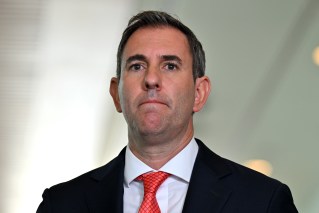Uncensored Rudd admits to batts system flaws

Opposition to Kevin Rudd’s plan to reveal the innermost secrets of the federal government lasted for a little less than 16 hours.
The former prime minister’s 31-page statement to the royal commission into the 2009 home insulation program was initially heavily blacked out or “redacted” at the insistence of government lawyers intent on protecting cabinet confidentiality.
Mr Rudd’s lawyer had insisted his client could not tell the truth about the disastrous program that claimed the lives of four young workers if he was not permitted to tell his story in full.
Resistance was strong on Wednesday afternoon but evaporated on Thursday morning, when government lawyer Tom Howe QC said the Commonwealth supported “public ventilation” of everything Mr Rudd wanted to say.

Murray Barnes, father of victim Rueben Barnes, outside the court. Photo: AAP
What emerged from the document was Mr Rudd’s portrait of the prime minister and his ministers as entirely reliant on the information and advice placed before them by the public service – the people he described at the commission as the “wicketkeepers” of his home insulation scheme.
Starting with the reason for implementing the insulation scheme, Mr Rudd reveals that an all-weekend sitting of senior cabinet ministers – Julia Gillard, Wayne Swan, Lindsay Tanner and himself – in October 2008 was warned that Australia faced recession and a nine per cent unemployment rate if nothing was done to combat the unfolding global financial crisis.
One response was the $2.8 billion home insulation scheme, devised as a make-work scheme to boost the economy.
Much of what was initially redacted from Mr Rudd’s statement is simply anything mentioning cabinet processes, however mundane, but some reveal that even after people started dying, no alarm was raised about the program.
Mr Rudd described a briefing system used by the Department of Prime Minister and Cabinet to warn cabinet about “any programs going off the rails”.
The reports were colour-coded: green for “on track”, amber for “maintaining close watch” and red for “in difficulty”.
From its July 2009 inception to until February 2010 when its immediate closure was urged, the program was never rated anything other than green for “on track”.
Among other details is Mr Rudd’s recollection of a January 28, 2009, cabinet meeting that considered the rollout of the Home Insulation Program.
Issues discussed concerned timelines and costs, Mr Rudd says, but workplace safety standards never came up.
The statement also shows a public service task force was set up four days after the February 4, 2010, death of Mitchell Sweeney, who was the last worker to die during the life of the scheme.
On February 17, the taskforce advised Mr Rudd’s cabinet committee of senior ministers of “significant program design risks, notably safety risks … and the need to exit the overall program”.
The same day the committee accepted the taskforce’s recommendation to terminate the program.








